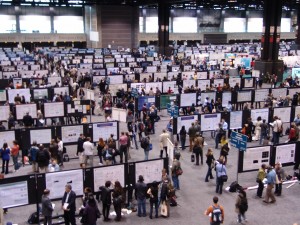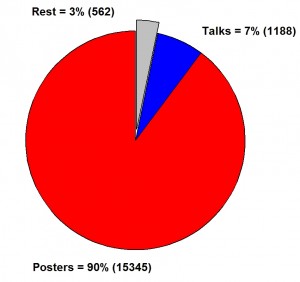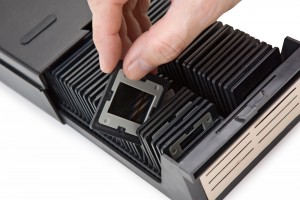We already discussed the basics of the art of SfN conferencing in a previous post, but let’s add meat to the bones.
Our story starts in a long forgotten era, a time before Facebook, Youtube and – ironically (?) – well before the mainstream popularity of blogs. It might sound incredulous in this day and age, but I didn’t even have a cell phone yet. The year? 2002. I had just entered grad school, was probably a little too cocky for my own good (although probably not more so than your average first year grad student, but that is a story for another day…) [Note 1: Humility and modesty are virtues. They are to be striven for. ]
That year, the meeting was held in Orlando, FL (the first and as of yet only time the meeting took place there). Naturally, I was quite excited about the meeting, but lacked every skill to make it a successful one. Worse – I was unaware of it. [Note 2: Properly “doing” a mammoth conference like SfN requires considerable skill. If you are unaware of this, you probably lack this skill.]
At this meeting – my first SfN meeting – I learned preciously little of scientific value. But I did learn a lot about what not to do, and how to completely exhaust yourself for no good reason whatsoever. I am sharing this story with you so that you can learn from my mistakes (instead of making them for yourself).
The trouble started pretty much right away. As I had no idea what is going on, a more senior grad student had taken it upon himself to reserve the rooms for all non-PI lab members (me, himself and another grad student). When we showed up at our hotel, it turned out that there was no room for us at the inn. Somehow, the reservation had not been made or not been made properly. Given the fact that there were 25,000 other pilgrims in town, the hotel staff could not help us. Worse, *all* conference hotels seemed to be booked solid. After some frantic phone calls, we were ultimately able to secure a stable/motel of sorts a couple of miles out of the way. Luckily, it turned out to be next to an official conference hotel. This means that we could walk over and sneak onto one of the official SfN shuttle to the conference center that are operated by the society for this purpose. This was an important lesson to be learned. Ever since, I took a much more proactive role in booking the hotel rooms for the conference and *always* insisted on an email confirmation. I make sure to bring a printout of this confirmation email to the hotel. I am happy to announce that this policy served me rather well. [Note 3: It can really make a difference to have proof of reservation with you when you show up at the hotel. A clerk at our hotel in Atlanta 2006 had apparently sold our room to the highest bidder, adamantly denying that we ever had made a reservation. When making our case with someone else from the desk staff, it tremendously helped our case to have a hardcopy of the reservation confirmation at hand – we ended up getting the room, after only some further discussion.]
Going forward, this false start did negatively impact the entire conference experience. As already alluded to, our new place was rather far from the convention center. Having to wait for the shuttle (which kept an erratic schedule, as far as I could tell), waiting for it to pick up all the people on its route and slowly making the trek to the convention center necessitated rising at an ungodly hour in order to make the morning sessions in time. The same thing applied in reverse in the evening, when everyone rushes out to board the shuttle back to the hotel. As this was my first SfN meeting, I was well in over my head anyway, and these transit logistics ate into valuable time. [Note 4: If at all possible, I strongly recommend staying within walking distance of the convention center. I cannot emphasize this enough. It doesn’t have to be the fanciest hotel, it doesn’t have to be single rooms. So what if the place is not the Ritz? I’ll only use the room to sleep anyway, perhaps for 6-7 hours a night, on average. So what if there are 4-6 people in one room? As long as it is close and affordable, it is all good. The hotel room is the last place where you want to spend any time during the conference. Regardless of anything else, I have religiously observed the “stay-within-walking-distance-at-SfN policy ever since. I am happy to report that cutting down on transit time really makes a difference. This poses somewhat of an ethical dilemma. Given the scope of SfN, not everyone can stay next to the convention center. There is simply not enough room. I am convinced that the society is trying to do their best to provide affordable housing to the masses of attendees, and provide free shuttles to and from the meeting. But that does not change the fact that distance matters. SfN implicitly agrees with this. The headquarter hotel is typically across the street from the convention center. The bad news is that this does matter and that I am pointing this out a little late. The good news is that there is always a next meeting (it pays to be organized), that the clustering of conference hotels in San Diego is advantageous this year (there are only 4 clusters – Downtown, Harbor Island, Mission Valley and Shelter Island, with the bulk of the hotels being downtown (where the distance to the convention center is quite manageable by walking. Speaking of walkability: San Diego downtown is not bad, as far as US cities go: Walkability of downtown San Diego)), and that you – now that you committed to a hotel will probably end up liking it anyway. The literature strongly suggests this, even if the reasons are contested).
In any case, my first day at the conference was consumed by finding a hotel, registering (picking up credentials and meeting books) and walking around dazed and confused. I swore to make up for this on it during the next day. So at night, I perused the program, marking everything that looked remotely interesting. [Note 5: Big mistake. Too much, too late. This issue is so central to a successful meeting that it needs elaborating. Thus, I will devote an entire future post to it.]
My basic plan during that meeting: Visit two morning sessions of talks (8 to 11 am, catching 12 talks, then go to two poster sessions from 11 to 12, catching another 20 posters. Then lunch, then doing the same in the afternoon session for a total of 24 talks and 40 posters/day, then go to the evening lectures. Trying to implement this overly ambitious plan was a complete and unmitigated disaster. Sure, I did see a lot of potentially interesting stuff, but understood little and retained next to nothing (in terms of specifics that could aid my research in the long term). The logistics also proved prohibitive. Short-changing the poster sessions like that was a disastrous mistake. Most morning talk sessions end around 11 am; in other words, I was not the only one who had the idea to hit the posters at that time. To say that the poster sessions were crowded would be a gross understatement. Hurrying from poster to poster, not being able to talk to the presenter either because of the huge crowd (at popular posters), or because the presenter had given up at that point (at unpopular ones) defeated the entire purpose of attending a poster session in the first place. The whole point of visiting a poster is that you can interact with the presenter. In other words, while technically “hitting” all the posters on my long list (actually, there were some no-shows, about 4-5%), I got very little out of the poster sessions. Now, make no mistake: The poster sessions are not some kind of afterthought. Quantitatively speaking, the posters ARE the meeting. If you miss out on the posters, you are missing out on the meeting. The quantitative structure of the meeting is quite striking (see figure).
[Note 6: When making your conference plan, make sure to allocate sufficient time to the poster sessions. Quantitatively speaking, most of the official science at SfN happens at poster sessions. Attending a poster also gives you the unique opportunity to interact very closely with the people whose papers you read. But be careful not to overdo this. Experienced poster presenters can usually spot a tire kicker when they see one, and obvious schmoozing is frowned upon.]
Attending the talk sessions was similarly taxing (this was in the time before wireless internet was readily available). As I didn’t know what is important and relevant (to me) and what is not, I simply tried to attend everything that sounded interesting. It is worth pointing out that the session titles usually have very sweeping titles, such as “Attention I” or “Visual Cortex: Architecture and Circuitry I” (how can one be in neuroscience and *not* be interested in that?) but the individual presentations that make up a session usually deal with one, very specific question in a highly technical manner, often assuming that you already know all the necessary background that makes the question interesting and the answer meaningful. This is not the fault of the presenters. This is not a college lecture. Doing it like that is really the only way to give a good and coherent talk in 12 short minutes. However, this means that if the specific question is not relevant to you, or you lack the necessary background to understand the answer, you just squandered precious conference attention and time on something (however good the presentation might be objectively) that you are unlikely to retain. [Note 7: Do not be taken by the anxiety to miss something. In order to get something worthwhile out of the talks, you will have to sift. Going to everything that sounds remotely interesting is admirable but not practical at SfN. There is too much going on in parallel (the meeting has about 100 parallel tracks, whereas most smaller meetings are one-tracked). As pointed out before: Focus on a countable number of presentations. When in doubt, ask your friends, lab members and colleagues what is worthwhile.]
To clear up some confusion about talks: “Talk sessions” at SfN were previously known as “slide sessions”. Recently, SfN changed the nomenclature (for reasons that are not entirely clear to me) to “Nano-symposia”. For all intents and purposes, this is merely a change in label. So if you are re-visiting SfN after a hiatus of a couple of years don’t be confused what happened to the talks. They are still here. In a sense, the relabeling is apt – at SfN, no one has given a presentation using actual slides in a very long time.
I would like to use this opportunity to introduce the notion of “pico-symposia”, to really streamline things. This would be suitable to accommodate talks that explicitly deal with very straightforward theoretical questions, such as “what is the effect of x on y?”. Each pico-symposia would last for 3 minutes: 1 question slide (“What did we want to know?”), 1 methods slide (“What did we do”?), 1 results slide (“What did we find”?) No affiliation and acknowledgments slide, no background slide, no discussion/interpretation slide (let the audience make up their own mind what the results mean). 1 minute Q&A (1 question). If TED can do it, why not SfN?
There is much more to be said on how to have a successful SfN, e.g. about non-poster/talk presentations, but this post is already getting way too long, so I’ll farm it out to yet another post on this issue.





Pingback: SfN 2010: The 100-hour dash | Pascal's Pensées
Hello Pascal,
I am writing to request permission to use your photo ‘The view from above – Poster Session SfN Chicago 2009’ in a poster I am presenting at a teaching conference (Uplegess Strasbourg May 2015).
My poster concerns a teaching project about a poster session we do with our students. I would like to illustrate our project with a photo of a real poster session (as well as photos of our student version).
Thanks for your attention,
Alexandra
Sure. Glad you are fond of it.
Hi Pascal, may I use your picture – the view from above – on a blog post on conference posters?
Cheers for now,
Barbara
Yes. With proper source credit, this is a permission to use it for you and everyone else who wants to use it.
Good luck.
Thanks for the blanket permission. I’m using it in an assignment sheet for my first-year writing class, linking to this post as well.
Hey Pascal,
thank you for your two blog posts. They helped me mentally preparing for the annual meeting. Am looking forward to it.
Best wishes,
Nils